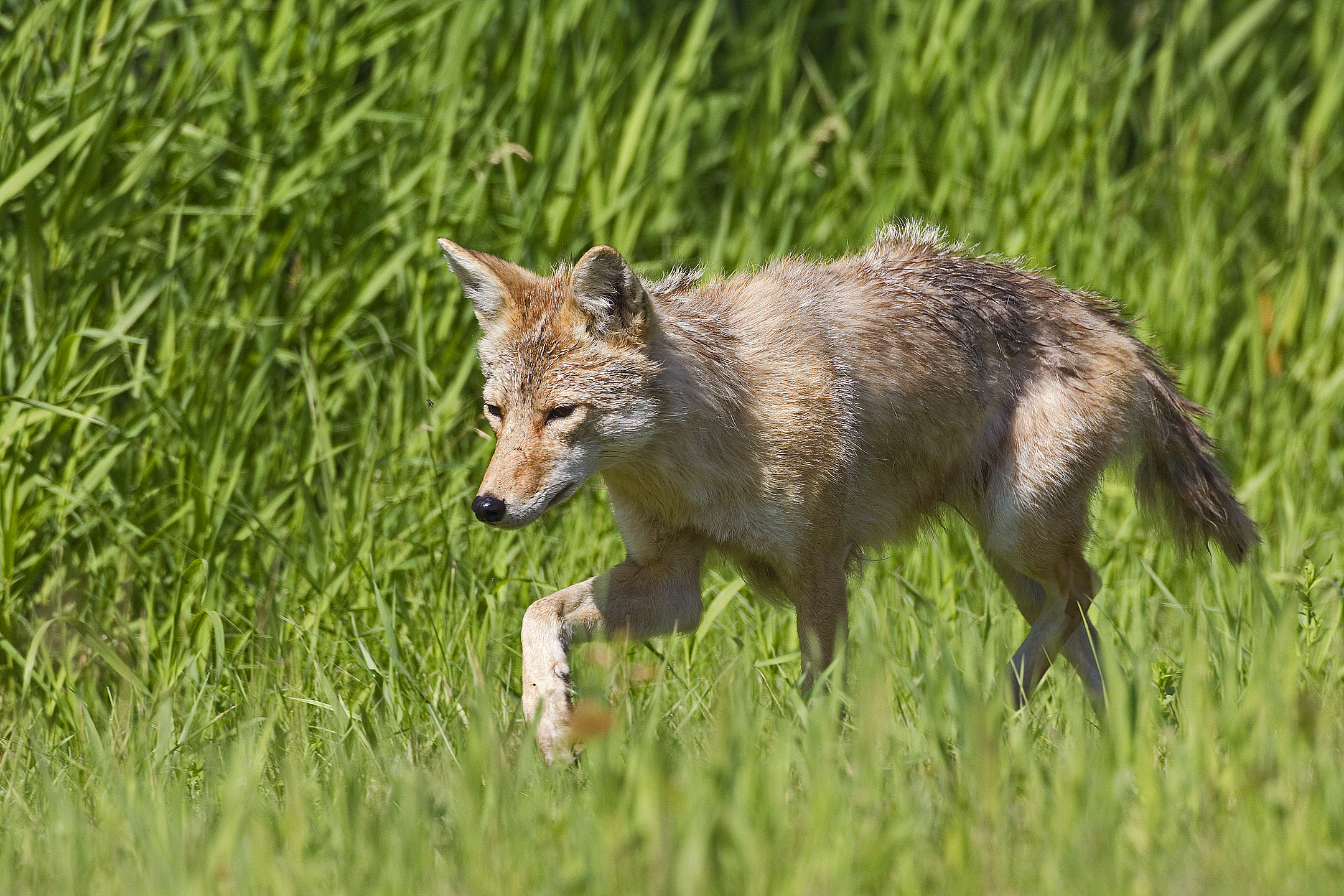Coyote (Canis latrans)
The coyote is a medium-sized wild canine, a relative of both the wolf and your family dog, though a coyote has several distinct features and traits. Coyotes are also extremely resourceful animals that have learned to survive and thrive in large cities, while other animals struggle with shrinking habitats. It is not uncommon to spot an urban coyote in the city or by the highway, looking for food.
Photo by Gerald Romanchuk
Why They Matter to Us
Coyotes are clever, resourceful animals who spark curiosity and awe in many people. However, their clever, resourceful manner can also lead to human-coyote conflict.
A key link in the chain
Since the decline of the gray wolf, coyotes have played an important role as a top predator in Alberta.
Top predators such as the coyote keep the population of small mammals, such as jackrabbits, in check.
Without a top predator, a chain reaction occurs where herbivores exhaust their food supply, which leads to less seed production, a loss of biodiversity, reduced habitat for other birds and mammals, and increased soil erosion.
As scavengers, they help clear away hazardous animal waste.
How You Can Help
Support protected areas in the Edmonton region (such as EALT!). You can donate or volunteer your time to help with conservation efforts. Our natural areas contain excellent habitat for coyotes and their prey. Coyotes, or signs of coyotes, have been observed at all of our natural areas. A female coyote has made her den and raised young at our Glory Hills property.
Help prevent coyote habituation. In order to co-exist with coyotes, there are various ways you can avoid human-coyote conflict:
When you encounter a coyote act aggressively – shout in a deep voice, wave your arms, throw non-edible objects towards the coyote, and make yourself look big.
Never run away from a coyote: like with most dogs, this behaviour makes them want to chase after you.
Secure anything that attracts coyotes to your property (garbage, compost, birdseed, pet food, fallen fruit).
Keep cats and small dogs indoors or supervised, and keep them on-leash in park areas.
Never feed a coyote either in person or by leaving food for it.
How to Identify
Identify by Sight
It is easy to mistake a coyote for a wolf, and vice versa. However, there are several notable differences: coyotes are generally smaller and lighter in build than wolves, with larger ears and smaller feet in comparison to their body size. The red markings on their snouts and ears also make coyotes stand out, and coyote noses tend to be long and pointed.
Fox: Gerald Romanchuk, Coyote: Public Domain, Wolf: Stephanie Weizenbach, Source for Measurements: Animal Tracks of Alberta
Identify by Sound
Coyotes communicate with each other through a variety of calls, including howls, yips, yelps, and barks. They call most often at dusk or at night, but may call during the day. Coyotes will call most often in the spring and the fall, especially during mating season.
Listen to coyote calls here.
Where to Find
In general, coyotes live throughout Canada and the US, ending up as far north as Yukon, but also able to live as far south as the deserts of Arizona. In Canada, they mostly live in south, central, and western Canada. Residents of Edmonton commonly spot coyotes near the river valley and outer edges of the City.
Possible coyote habitat includes forests, grasslands, deserts, swamps, mountains, and also agriculture, suburban, and urban areas.
Social Life
Coyotes live in packs, mated pairs, or alone. Unlike a wolf pack, a coyote pack usually has up to six members, all of the same gender, and they may not stay together very long. A mated pair can stay together over several years, but not necessarily for life.
Mated pairs raise litters in a den.
Food Chain
Coyotes are omnivores and will eat anything they can find. They eat hares, mice, squirrels, frogs, and carrion (dead meat). They also eat vegetation and wild berries when they are plentiful.
Humans are the primary danger to coyotes, though coyotes are also preyed upon by wolves, cougars and bears.
Fun Facts
The name “coyote” comes from Mexican Spanish, ultimately derived from the Aztec word cóyotl, meaning “trickster.”
In the mythology of several indigenous North and Central American cultures, the coyote is indeed regarded as a trickster figure.
Its scientific name, Canis latrans, is Latin for “barking dog.”
A coyote can locate a prey hiding under the snow using its ears.





